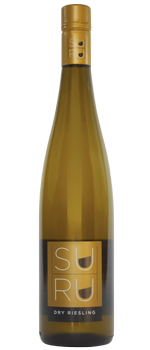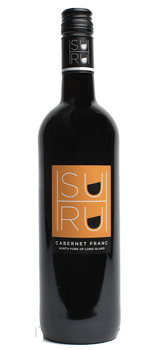Suhru Blog
Corks vs Screw Caps
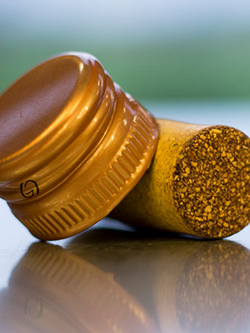 Ever wondered about the differences between the traditional cork closure and the more modern screw caps? Today we are taking a deep dive into the two technologies and shedding light on the history and benefits of the two!
Ever wondered about the differences between the traditional cork closure and the more modern screw caps? Today we are taking a deep dive into the two technologies and shedding light on the history and benefits of the two!
A Brief History of the Corks
Cork has been in use since 3000 BC and is used in a wide variety of products including shoes, flooring, bags, and of course as a closure for wine. Cork products are made by harvesting the bark of a Quercus Suber oak trees aka a Cork Oak, which takes 25 years of growth to reach maturity and to a point where the bark can be harvested. The process of harvesting is done by hand by specially trained cork harvesters who strip the bark from the trees using an axe.
As an organic material cork is a wonderful natural product, however as with any organic material it is subject to contamination. One of the reasons cork has been the material of choice for centuries is that its porous nature allows gradual oxidation for the wine as it bottle ages. However because it is a natural product there can be quite a lot of variation from cork to cork which can lead to something called sporadic oxidation.
Sporadic oxidation is the result of inconsistency in pore size of the cork, leading to the allowance of more or less oxygen to pass through the cork into the bottle. This can result in a browning in color, maderized (baked or stewed) character, loss of primary fruit and a general flattening of flavors and shortening of the finish of the wine. This comes from the varying elasticity of the corks, more or less lenticels (holes size and quantity), the internal bore of the glass neck, imperfections of the corking machinery can cause slices in the cork all of these can create variable issues with a perfect seal.
Cork Contamination aka "Corked" Wine
One of the other most commonly referred to downsides of cork closures is TCA (trichloroanisole), the primary form of wine contaminantion, also referred to as a “corked” or spoiled bottle of wine.
TCA is created when chlorine comes in contact with molds that form naturally in the bark of Quercus Suber oak trees. Chlorine is introduced during the washing of the bark when it is cut and from spray residue from pesticide sprays on the trees. Some of the tell-tale signs of a TCA contaminated or "corked" bottle of wine is a ‘wet-cardboard’ and ‘wet dog’ aromas, paired with suppressed fruit and a shortened finish. The flavor and aromas are distinct and are easy to pick-out once you know what to look for. The wine industry estimates that between 5-10% of all wine bottled under cork has some level of TCA.
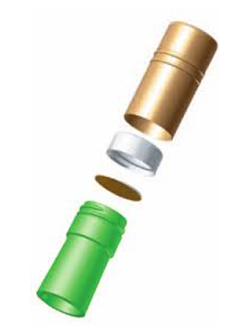 Introduction of Screw Caps
Introduction of Screw Caps
In August of 1889 Dan Rylands of Barnsley in the UK patented the screw cap, however it would be another 70 years before screw caps were used in wine packaging.
If you look inside a screw cap you will see a coating on the interior which is its PVDC liners (polyVINylidene chloride) essentially the ‘wine-proofing layer.’ This is then coupled with either Tin or Saranex backing based on the winemaker's preference. Tin linings (which are 10% more expensive) prevent oxygen exchange and retain freshness in a wine. Tin linings are primarily used for white and rosé wines. On the other hand, saranex linings which are mainly used for red wines allow the wine to breathe.
In 1959 a French company, Le Bouchage Mecanique (now Pechiney) was the first to use screw caps on a wine bottle. In the 1960's a Bordeaux winery bottled multiple vintages in screw caps as a trial to test out the new technology. Unfortunately for them they used paper wad backing not saranex in the cap. Ten years later in the early 1970's the Swiss wine industry was the first to fully embrace the new screw cap closures and by 1980's it was the predominant closure being used.
In the 1970’s Australia confirmed the superiority of the closure for red and white wines using tin or Saranex depending on the wine, but the change was met with strong consumer resistance. However in the early 2000’s the industry once again embraced this closure (starting with Claire Valley high-end Riesling producers) and over the last two decades screw caps have gained industry and consumer popularity across the globe.
Corks vs Screw Caps, Which is Better?
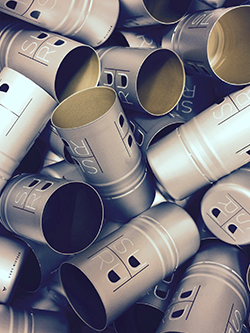 A closure has a direct impact on the quality, stability, longevity and even proper storage of the wine. While cork has been the historic choice and for a great many years was the best option available, in the modern age screw caps have become superior due to the consistency they provide.
A closure has a direct impact on the quality, stability, longevity and even proper storage of the wine. While cork has been the historic choice and for a great many years was the best option available, in the modern age screw caps have become superior due to the consistency they provide.
Screw caps offer a reliable seal that is consistent from bottle to bottle unlike cork which due to the fact that it is an organic material has slight variations from one cork to another that result in slight differences, and sometimes spoilage in the bottle.
One of the other main benefits and one that is often overlooked is that screw caps are inert, meaning they are flavorless and do not add any flavor (be it positive or negative) to the wine. On the other hand corks, introduce flavor both positive through slow oxygen exchange which allows wine to age in the bottle as well as negative (TCA) which results in spoilage. Screw caps, while inert, can be customized to allow for gradual slow oxygen exchange by adding a foam insert to the top of the screw caps interior thus mimicking the slow oxygen exchange of corks.
Temperature is often discussed as one of the main detriments to wine as it deteriorates the quality of the wine over time and causes spoilage. If you have ever opened a bottle of wine after it has sat baking in a car on a hot summers day you know what I'm talking about, the wine gets "cooked" and no longer tastes as it should. While a wine can get "cooked" no matter what closure you have, when a bottle with a traditional cork closure reaches 85 degrees Fahrenheit the cork will start pushing its way out of the top of the bottle exposing the wine to more oxygen and increasing the rate of spoilage/oxidation over time, whereas with screw caps you don’t run into this issue as the caps can hold more internal pressure and therefore are less effected by temperature swings.
Another main benefit of screw caps is their price, while pricier options do exist, there are affordable options when compared to many of their cork/capsule counterparts, meaning less packaging costs for the winery and therefore a better bottle price for the consumer, a win-win for everyone! For comparison, a natural cork costs $0.25 - $0.45 per cork plus the capsule is an additional $0.15 for polylamanents or roughly $0.02 for plastic. A stelvin screw caps costs $0.18 per cap and the higher end lux screw caps costs $0.50.
And if all of that wasn't enough to convince you that screw caps are the way of the future, one of our favorite features are how easily screw caps can be opened and resealed. No need to struggle with a corkscrew or ensure you have one on you, all you have to do is give the bottle a quick twist and your wine awaits! In addition to the ease of opening, screw caps are a green product, the are cost effective and easily recycled. Aluminum (what screw caps are made of) happens to be the most cost effective material to recycle and if that's not a plus I don’t know what is!
Suhru has been proudly packaging our wines under screw caps since we opened in 2008 and have seen great success in the age-ability of our wines under these closures. Many experiments have been done in regions across the world comparing screw caps to cork and the screw caps has come out equal if not better than the cork at aging in may cases. While it may be a "less romantic" way to open your wine, you can't beat the convenience!
Our Favorite Holiday Cookie Recipes
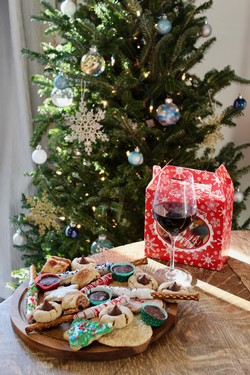
The only thing better than milk and cookies, is wine and cookies (if I do say so myself)! As is true for most people, I love the holidays! Cutting down a Christmas tree, lighting the menorah, driving through the neighborhoods and seeing the North Fork all lit up with lights, there is something truly magical about it all!
While I do love all of the festivities and decor, one of my favorite things to do during the holiday season is bake! As the members of the Suhru Wine Club can attest, we take holiday baking VERY seriously here at Suhru Wines so I wanted to take this opportunity to share a few of our favorite family cookie recipes! Checkout the complete recipes here!
And whether its while cooking up a storm in the kitchen or relaxing with family and friends ticking in to the delicious confections wine is never far from hand. Two great wine pairing options for holiday baking are Sparkling Brut, always a classic choice, and Ember, our Bordeaux blend which is an incredibly versatile red wine. So cheers to the holidays and time well spent with friends, family, good food and great wine!
We'd love to know what you and your families bake this time of year, so please comment below with your favorites as well. Wishing you and yours a very happy holidays and a happy, healthy New Year!
Thanksgiving Wine Pairings
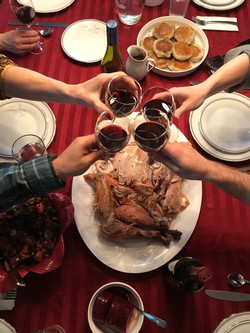 Thanksgiving is just around the corner and we've pulled together four of our favorite wines to pair with Thanksgiving dinner to give you a little inspiration when you're planning your own holiday meal. The most important thing to remember when it comes to pairing is there are no wrong answers! However if you're seeking for a little more insight into the wine and food pairing world, our general tricks of the trade are to think about your pairings in one of two ways, (1) likes with likes or (2) opposites attract.
Thanksgiving is just around the corner and we've pulled together four of our favorite wines to pair with Thanksgiving dinner to give you a little inspiration when you're planning your own holiday meal. The most important thing to remember when it comes to pairing is there are no wrong answers! However if you're seeking for a little more insight into the wine and food pairing world, our general tricks of the trade are to think about your pairings in one of two ways, (1) likes with likes or (2) opposites attract.
When it comes to pairing there are two general ways to approach it, pair a wine with a dish with similar flavor profiles so a peppery wine with a peppery dish for example which will elevate that characteristic in both but may mask some of the other flavors. The other approach is to compliment opposite flavor profiles, for example pairing a bright, crisp Dry Riesling with a savory, herbaceous, heavy plate of turkey, stuffing, potatoes and gravy. The bright crisp acidity will cut through the fat on the plate giving your palate some relief from the heavier flavors and offering some contrast to engage all of your taste buds. No matter which approach you choose, the end result will be magnificent because when you have good food and good wine you can never go wrong!
Dry Riesling
Riesling is one of our favorite wines to pair with food because it is made in the dry style while still maintaining a light, fruity hint of sweetness which gives it a wide range of pairing options! Dry Riesling pairs beautifully with succulent, savory dishes like a holiday roast turkey as well as with sweeter, more indulgent dishes like homemade apple pie!
If you are looking for a white wine to have on your holiday table this year, look no further! Always a crowd pleaser the bright acidity and crisp citrus notes on this wine make it a beautiful wine to pair with any holiday dinner.
Tasting Notes: made entirely in stainless steel tanks to accentuate the minerality of the wine, this award-winning Dry Riesling retains a zingy vibrant acidity. Rich stone fruits of apricot and clementine abound from the glass with a hint of lime leading into a bright wine on the pallet with mouthwatering acidity and hints of peach, apricot and pomelo. A light sweetness softens the acidity resulting in a soft, pleasingly long finish. Learn More
Rosé
While maybe not the first wine style that comes to mind when you think "Holiday Dinner," dry rosés are a beautiful addition to any holiday meal as they offer all of the the bright, refreshing qualities of a white wine while still maintaining a hint of the body and depth of flavor of a red.
Versatility is key when it comes to rosé! The reasons that you love a glass of rosé on a hot summer day (it's bright, crisp, and refreshing) make it an excellent addition to a holiday meal. Rosé provides that same bright, crisp, refreshing quality to the heavy, lavish meal you are about to enjoy.
While rosés can easily hold up to the full range of Thanksgiving dishes, some of our favorite pairings include homemade cranberry sauce, apple cake, and cranberry walnut brussels sprout salad. And in case you missed it, checkout our Fall Mulled Rosé Recipe, which is a great pre-dinner cocktail to kick off the holiday!
Tasting Notes: a delicate Provencal style rosé with soft, subtle aromatics, hints of pink grapefruit zest on the nose and a vibrant acidity. Soft, zingy fruit notes of raspberry and cranberry on the palate lead into a soft finish with lingering, lively acidity. Learn More
Teroldego
If ever there was a wine that we are excited to enjoy this holiday season this is it! Our newest release and the latest addition to the Suhru Wines portfolio, Teroldego is a perfect pairing wine for the season! With all of those beautiful baking spice notes and those bright red fruit notes it pairs well with just about anything!
This wine pairs so well with so many dishes and flavors but a few tried and true favorites are walnut goat cheese pear salad and Moms brisket! From salads to meats with this one you really can't go wrong. If you're like me, the epitome of luxury is a glass of red wine with dessert, the number one thing I am most looking forward to this Thanksgiving is enjoying a glass of Teroldego with a big ol slice of homemade apple pie! Nothing more Thanksgiving than that!
Tasting Notes: an enticing rich purple, this lesser known Northern Italian varietal has aromas of red rose petals, red currant, and red raspberry that abound from the glass. The pallet has bright red fruit notes including raspberry, red cherry and anise with savory hints of slate and oyster shell on the finish. The fine tannins and bright acidity on the finish make this an extremely food friendly wine. Learn More
Cabernet Franc
A classic holiday pairing, Cabernet Franc is often recommended to pair with Thanksgiving dinner. Cab Franc has those beautiful fruit notes as well as a light pepper spice which makes it such a wonderful wine for any holiday table. The white pepper notes play beautifully with a bolder meal while the brightness of the fruit cuts through those heavier flavors. Pair a glass of this with a roast turkey, stuffing and all the sides and you'll be sitting pretty this holiday season!
Tasting Notes: with bright red fruit notes of black currant, raspberry, and a hint of anise. This bold red has notes of mocha and cocoa and a nice mid pallet giving way to fine, lingering tannins and a light smokiness with the slightest hint of vanilla. Learn More
Shop Suhru Wines
Available to ship to 40+ states!
Harvest Update: November 2020
Our 2020 Harvest has come to an end at Suhru. All of our grapes have been picked and are now busy fermenting into wine! While our fruit has all been picked, the work is far from done! Our white wines are completing the fermentation process while for the reds, the journey from grape juice into wine is just begining.
What's Happening in the Winery
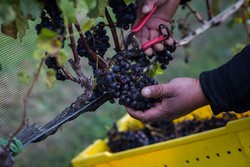
Over the last week the focus in the winery has switched over to red wines, so we thought we'd take a quick moment to briefly review how red wine is made. Once our reds have been hand-harvested and delivered by tractor to the winery the grapes are destemmed and the grape must (aka berries, juice, skins, seeds and all) are pumped into open-top tanks where the magic of fermentation occurs.
All of the tanks at the winery are temperature controlled as temperature is key during fermentation. Yeast (the essential ingredient in turning juice into wine) like very specific conditions—too warm the yeast will over heat and die, too cold the yeast will fall dormant.
When the grape must reaches 60 degrees it is time to inoculate (aka add yeast)! Throughout fermentation the yeast cells will consume the natural occurring sugars in the grape juice, producing alcohol and releasing carbon dioxide. During the ferment as CO2 is released it rises, lifting the skins to the top of the tank forming a "cap".
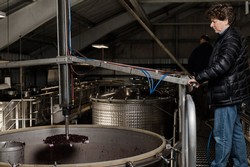 We need to ensure that the juice stays in contact with the skins throughout the fermentation process as the skins are what give red wine its color. As a result, throughout fermentation we "punch-down" the grape skin cap that forms at the surface of the tank in order to reintroduce the skins to the juice. This process will be done multiple times a day at the beginning of fermentation, gradually slowing down as the rate of fermentation slows.
We need to ensure that the juice stays in contact with the skins throughout the fermentation process as the skins are what give red wine its color. As a result, throughout fermentation we "punch-down" the grape skin cap that forms at the surface of the tank in order to reintroduce the skins to the juice. This process will be done multiple times a day at the beginning of fermentation, gradually slowing down as the rate of fermentation slows.
Once the fermentation process is complete and all of the sugars have been converted to alcohol, the the grape seeds will settle to the bottom of the tank while the grape skins float homogeneously with the wine. At this time the juice is drained off and pumped into another tank and in order to ensure we get every last drop of wine. The remaining skins are shoveled out of the tank and loaded into the press where we extract the remaining wine.
From here the wine is racked into oak barrels where it undergoes secondary fermentation or malolactic fermentation. During this second fermentation process the sharp, astringent malic acid is converted into lactic acid which gives the wine a softer, rounder mouth-feel and more pleasant drinking experience. Once this process is complete the wine is racked into clean barrels where is will stay in our temperature controlled barrel room for the coming months as it ages.
A Note from Winemaker Russell Hearn
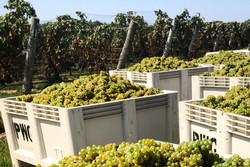 Harvest 2020 started out nicely with the white and rosé fruit ripening in a dry pleasant weather pattern. All of our white and rosé varieties came into the winery looking very nice and are now fermenting along cleanly in tank. Our Sauvignon Blanc and Pinot Grigio fruit came in looking especially nice with full fruit maturity. Our Cabernet Franc and Merlot which will be used to make our 2020 Rosé were picked during a cool spell so they both retained nice natural acidity.
Harvest 2020 started out nicely with the white and rosé fruit ripening in a dry pleasant weather pattern. All of our white and rosé varieties came into the winery looking very nice and are now fermenting along cleanly in tank. Our Sauvignon Blanc and Pinot Grigio fruit came in looking especially nice with full fruit maturity. Our Cabernet Franc and Merlot which will be used to make our 2020 Rosé were picked during a cool spell so they both retained nice natural acidity.
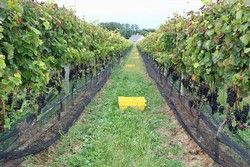 However after a beautiful summer and nice September, October has given us a run for our money! The second half of October turned wet and humid with below average temperatures so we have seen some delays in the red fruit which means that some of the red varieties out here will not be picked at the high level of quality that they otherwise could have been. Therefore, we have chosen to only make Teroldego this Harvest as it is an early ripening variety and was not as impacted by the uncharacteristic weather as the other red varieties. Our Teroldego was picked on October 26th probably 7-10 days later than normal which is one of the benefitw of it being an early ripener, even in a cooler than normal year it still ripens. The Teroldego fruit looked beautiful coming into the winery and is now busy fermenting away in tank. We look forward to seeing how this wine continues to improve and evolve throughout the fermentation process!
However after a beautiful summer and nice September, October has given us a run for our money! The second half of October turned wet and humid with below average temperatures so we have seen some delays in the red fruit which means that some of the red varieties out here will not be picked at the high level of quality that they otherwise could have been. Therefore, we have chosen to only make Teroldego this Harvest as it is an early ripening variety and was not as impacted by the uncharacteristic weather as the other red varieties. Our Teroldego was picked on October 26th probably 7-10 days later than normal which is one of the benefitw of it being an early ripener, even in a cooler than normal year it still ripens. The Teroldego fruit looked beautiful coming into the winery and is now busy fermenting away in tank. We look forward to seeing how this wine continues to improve and evolve throughout the fermentation process!
Checkout Previous Harvest Updates.
Cooking with Suhru: Mulled Rosé

When most people think of rosé they think summer, but this delicious style of wine cannot be confined to just one season! It's getting colder and colder every day and I don't know about you but I'm not ready to give up that summer feeling just yet which is why I've put together this yummy Mulled Fall Rosé recipe so we can keep the rosé summer loving going all year long (or at least for another few months)!
While we have come to think of Rosé and Summer as almost interchangeable, it's a great wine for Fall as we ease our way back into the bolder, fuller reds. Rosé is a perfect transition season wine because it's light and fruity like a white wine. but has a little more body and for a lack of a better word umph, like a red. Mix that with a couple warm baking spices and you have a Fall cocktail fit for a Queen (or King)!
Why not pick up a few bottles of Suhru Rosé and get cooking?!
Harvest Update: October 2020
What's Happening in the Vineyard
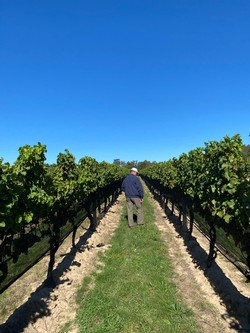 This time of year a winemaker spends a good portion of each day walking the vineyards, inspecting the fruit, and tasting the berries to determine their optimal ripeness and when they should be picked. Harvest is well underway on the North Fork and we are looking forward to picking several more tons of fruit in the coming weeks!
This time of year a winemaker spends a good portion of each day walking the vineyards, inspecting the fruit, and tasting the berries to determine their optimal ripeness and when they should be picked. Harvest is well underway on the North Fork and we are looking forward to picking several more tons of fruit in the coming weeks!
Our winemaker Russell has been walking the vineyards, inspecting the fruit, and testing the berries Brix (sugar) levels to determine their ripeness. Winemakers walk the vineyards for a number of reasons as there is a lot you can tell by looking at the vine and tasting the berry as to how the fruit is developing. Taste is a key indicator (as it is in every step of the winemaking process). By tasting the grapes you can assess the ripeness of the berry based on its sweetness as well as by the taste of the seeds.
If you have ever had the chance to taste a wine grape there are several seeds inside the berry. These seeds are a great indicator of a berries ripeness. Green seeds mean the grape is immature. As we walk the vineyard and taste the fruit we are looking for a desired sweetness level and a brown seed indicates that the berry has reached ripeness. An underripe seed can impart a "green" flavor to the wine and add an astringency to the tannins particularly in a red wine which will spend the first few weeks of its post-harvesting journey into wine, in contact with the skins and seeds.
What's Happening at the Winery
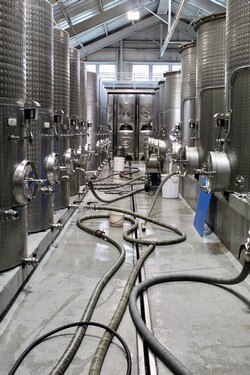 Harvest is well underway on the North Fork of Long Island! At this point in mid-September most of the fruit for sparkling, white wines, and rosés have been picked and have begun their fermentation process (which has been keeping our winery crew nice and busy these past few weeks). The red harvest will be starting shortly but we are enjoying the "calm before the storm" at the moment.
Harvest is well underway on the North Fork of Long Island! At this point in mid-September most of the fruit for sparkling, white wines, and rosés have been picked and have begun their fermentation process (which has been keeping our winery crew nice and busy these past few weeks). The red harvest will be starting shortly but we are enjoying the "calm before the storm" at the moment.
Once a grape has been harvested and brought into the winery there is a lot that needs to happen before that grape makes it into your glass—destemming, crushing, settling, fermentation, pressing, pumping, racking, barreling, and bottling—the journey from grape to wine is just beginning. We aren't going to dive into all of that just now (that would be a VERY long post) but let's talk briefly about the first few steps as they relate to what is happening at our winery at the moment.
Our white wines are "in tank" at the moment. When they first came into the winery they were destemmed and loaded into the press which gently squeezed the juice from the berries, leaving the skins and seeds behind. The discarded skins and seeds were then loaded into a truck and driven to the vineyard where they are being composted to be used to fertilize the vineyard for seasons to come. Back at the winery our white wine juice is pumped into tanks (as can be seen in the photo to the left). The juice is then left alone for a day or two to allow any solids to settle to the bottom.
Once the juice has settled, it is racked (the clear juice is pumped into another tank leaving the solids behind) at which point it is inoculated with yeast and the fermentation process begins. During fermentation, temperature control is essential. If the juice is too cold the yeast will go dormant and if too warm the yeast will die. All of our tanks are temperature controlled to create an ideal environment for the yeast to thrive as they consume the naturally occurring sugars in the grapes and convert them to alcohol. Once the yeast is finished consuming the sugars (all sugar is consumed when making a dry wine, fermentation is stopped while some sugar remains for a sweet wine) the fermentation process stops and the wine is again settled allowing the dead yeast cells to settle to the bottom of the tank. Once settled the remaining clear wine is racked into a new tank or barrel to begin its aging process.
6 Rosé Pairings Perfect for Fall!
Fall has always been one of my favorite seasons! I mean what's not to love?! There's apple and pumpkin picking, it's cozy sweater season, the temperatures start to drop and the leaves start to turn, fall produce hits the farm stands, and it is of course harvest season in the wine industry which makes for some very busy and exciting days!
There is so much to love about Fall but one of my ultimate favorite things about this season is the food! So I have collected a few of my favorite Fall recipes that pair perfectly with Rosé for all of you (like me) who while very excited about the changing of the seasons are not quite ready to say goodbye to summer just yet!
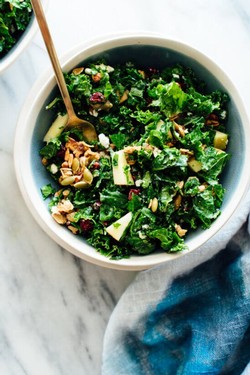 #1: Kale, Apple & Goat Cheese Salad with Granola “Croutons”
#1: Kale, Apple & Goat Cheese Salad with Granola “Croutons”
I love the Cookie and Kate food blog! If you haven't heard of this blog before I highly recommend it! My fiancé found it about a year ago when searching for a particular soup recipe and we have never looked back (and never had a bad meal)!
For me, Fall salads are the perfect transitional meal from Summer into Fall—they are light and bright and showcase the bounty of the Fall harvest while giving a solid nod to the Summer months when light, healthy, green foods are what we all (or I at least) lean towards.
It's not Fall without a kale, apple salad and this one is the perfect combination of bright, fresh flavors and warm Fall notes with the creamy richness of the goat cheese and the yummy crunch of the granola. Pair this with a bottle of Rosé and you have the perfect meal, the bright fruit favors of the wine perfectly compliment the crispness of the apples and the tangy lemon/maple dressing!
Checkout the Recipe on the Cookie and Kate blog!
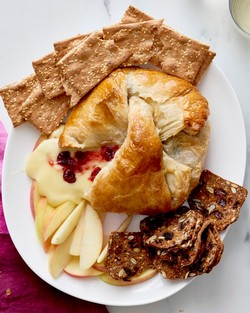 #2: Warm Baked Brie
#2: Warm Baked Brie
One of my ultimate favorite Fall/Winter snacks and the dish I bring to every holiday, celebration, or dinner party as it is always a crowd pleaser—Baked Brie! Because honestly you can't go wrong with warm melty cheese wrapped in pastry!
I have been making Baked Brie since my first high school French class potluck and there are a few tricks I have learned over the years that I recommend playing around with if you make one yourself! First of all, if you're going to add toppings, score the top of the brie before you wrap it in the pastry and put the toppings inside! There is no limit to the choices but my favorites have always been cinnamon, brown sugar and butter, raspberry or fig jam, or if you're looking to be festive around the holidays, whole berry cranberry sauce! They are all delicous choices but the jams and cranberry sauces add a nice bit of brightness and acidity to balance out the richness of the cheese. Enjoy this dish with apple slices and a glass of Rosé for a truly decadent and delicious meal!
Checkout the Baked Brie Recipe on The Kitchn!
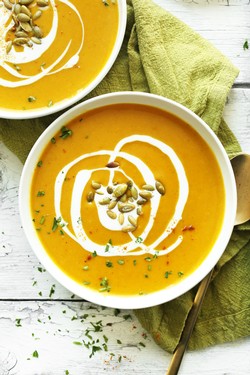 #3: Curried Butternut Squash Soup
#3: Curried Butternut Squash Soup
One of my all time favorite things about the cooler weather months are that they are a perfect excuse to pull out my soup pot and immersion blender and make all of the soup recipes I have been dreaming about all summer. Butternut Squash soup is of course a classic, but I like to give mine a little twist and make a curried soup giving it a little extra flavor and a nice kick of spice (I usually increase the amount of curry powder in mine but you do you)!
This recipe comes from Minimalist Baker, another fantastic food blog that I highly recommend you explore as there are lots of great recipes! Curried foods are great because they have a warming effect on your body which is particularly nice as the nights begin to cool. Given that, Rosé may not always be the first wine that pops to mind when you're having a curried soup. What makes this such a wonderful pairing, is that the bright fruitiness and crisp acidity cut through the spice. The acidity actually acts to "cool" your mouth from the spice. This is style of soup also pairs beautifully with our Dry Riesling, another under rated Fall wine.
Checkout the Recipe on the Minimalist Baker Blog!
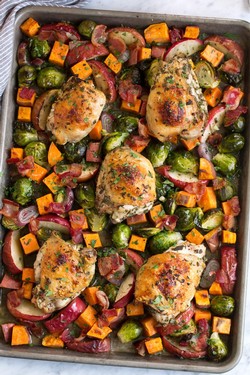 #4: Roasted Chicken and Vegetables
#4: Roasted Chicken and Vegetables
A full roasted chicken is wonderful but sometimes you just need a quick weekday meal. This a great infusion of Fall flavors without taking up too much of your time during what we all know is a busy time of year! I love one pot or one pan dishes because not only do they infuse all of the flavors but the cleanup is super simple!
This simple recipe nicely showcases all of the wonderful Fall veggies, keeping the roasted chicken breast center stage, and as an added bonus, there's bacon! I like to throw in a few sliced radishes as well to round out my roasted veggies (because you can never have too many)!
Chicken is a classic pairing with Rosé and is such a versatile food that pairs so well with so many types and styles of wine. The list of possible pairings with a dish like this is endless. I strongly encourage you to try it with a glass of Rosé if you never have before, I don't think you'll be disappointed.
Checkout the Recipe on Cooking Classy!
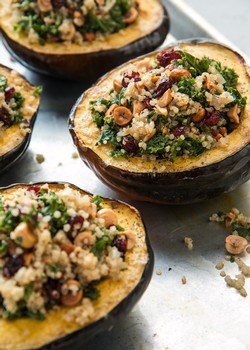 #5: Stuffed Acorn Squash with Hazelnuts, Quinoa, and Kale
#5: Stuffed Acorn Squash with Hazelnuts, Quinoa, and Kale
If you're not cooking squash in the Fall I don't know what you're doing! There are so many great ones out there and such a plethora of recipes it was hard to decide on just one. I have had my eye on this particular recipe for some time now and am looking forward to trying it out this weekend now that acorn squash is readily available. While this particular recipe is new to me, this idea is not, I make a lot of stuffed acorn squash each Fall! It is such a delicious food and as an added bonus this particular recipe happens to be both vegan and gluten free which is great for when you're cooking for anyone with dietary restrictions.
There is something about roasted vegetables that just makes me happy and acorn squash is no exception. Pair it with a savory, earthy blend of quinoa, hazelnuts, kale and cranberries and you can't go wrong. All this dish is missing is a little brightness, so pair it with a glass of Rosé and the fruit flavors of the wine will play perfectly with the light sweetness of the cranberry. Plus the nice bright finish will act as a nice contrast to the heavier, rich flavors of the meal!
Checkout the Stuffed Squash recipe on Will Cook For Friends!
 #6: Thanksgiving Turkey with Cranberry Sauce
#6: Thanksgiving Turkey with Cranberry Sauce
Thanksgiving turkey needs no recipe as each family has their own special secret recipe and family traditions. So I am going to skip over including a recipe link here because no matter how you cook a turkey, it's delicious!
My Thanksgiving dinner usually includes most of the dishes above because why not have all of your favorites on one of your favorite holidays?! That being said, a family tradition is our house is to start off Thanksgiving with some rosé (if any has managed to last that long in our house). It is a great way to start the day with a bright, crisp, light dry wine to cleanse the palate before the heavy meal. Much in the same way that cranberry sauce acts to cut through the richness of the meal and offer a little brightness to the plate, rosé can do much the same.
So this holiday season, why not add a few bottles of rosé to your table and see what happens? Who knows, you may just make a new family tradition!
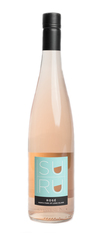 I hope you have enjoyed this glimpse into my Fall cookbook and have gotten a little kitchen inspiration! These are a few of my favorite Fall dishes but I would love to hear what you are cooking this Fall—please share your recipe recommendations in the comments below!
I hope you have enjoyed this glimpse into my Fall cookbook and have gotten a little kitchen inspiration! These are a few of my favorite Fall dishes but I would love to hear what you are cooking this Fall—please share your recipe recommendations in the comments below!
If you are in need of a little Rosé in your life, be sure to stockup while you still can! Shop Rosé!
History of the Grape: Teroldego
The latest addition to the Suhru Wines portfolio, we are very excited to share the release of our Teroldego! First released to our Wine Club in early September, this delicious new wine is now available at the Tasting House!
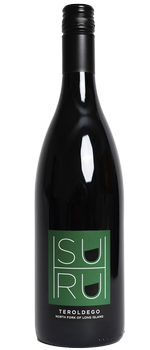 A perfect wine for the cooler Fall months, this unique red wine has warm baking spices on the nose with hints of anise, cinnamon, and red currant. Notes of red raspberry and wild briary fruit compliment the fine tannins and bright acidity on the finish making is a perfect wine to enjoy with a meal!
A perfect wine for the cooler Fall months, this unique red wine has warm baking spices on the nose with hints of anise, cinnamon, and red currant. Notes of red raspberry and wild briary fruit compliment the fine tannins and bright acidity on the finish making is a perfect wine to enjoy with a meal!
A Brief History of the Grape
Teroldego is a lesser known Northern Italian varietal (best known as the nephew of an old French variety that was the parent of Syrah) and is a rarity on the North Fork and in the US. To our knowledge there is only one vineyard on the East End with this grape variety planted and we are very excited to have gotten our hands on it!
Fun Fact: 97% of the world's Terolego’s production comes from Italy
Teroldego is found across the globe in California, Australia, New York and Brazil however the majority of the Teroldego vines planted are in Italy. An Italian red grape variety primarily found in the northeast region of Trentino-Alto Adige, it is believed that the name “Teroldego” came from the traditional method of cultivation in which the vines are trained on a system of “tirelle” or wire harnesses.
A cool-climate varietal, Teroldego is a hardy grape varietal that is known for being vigorous. It is best suited to permeable, well drained soils, making it a perfect grape to grow on Long Island where our soil is comprised of sandy loam soil with great drainage.
A Note from Winemaker Russell Hearn
 "Over the last 12 years Suhru has been committed to producing a small selection of wines, specifically selected to showcase the varieties that grow best in our region. Making a wine that you like is important, but it is more important to select a variety that grows well in the region otherwise as a winemaker I am setting myself up for failure, as you need great grapes to make a great wine.
"Over the last 12 years Suhru has been committed to producing a small selection of wines, specifically selected to showcase the varieties that grow best in our region. Making a wine that you like is important, but it is more important to select a variety that grows well in the region otherwise as a winemaker I am setting myself up for failure, as you need great grapes to make a great wine.
As my wine preferences have evolved over the decades I’ve found myself leaning towards elegant, over powerful red wines as they compliment rather than overwhelm the meal. This led me to further exploration of Italian wines, specifically wines from the Northern Alto Adige Region, where I happened upon Teroldego.
This variety is known for fruit forward, expressive wines with elegant tannin structure. Teroldgeo does not benefit from extended barrel aging, so can be bottled and released earlier than most of our other red wines and is an early ripener which is a huge asset in our region where hurricanes have been known to decimate later harvesting varieties. For all these reasons and more, when we discovered Teroldego planted on the North Fork we jumped on it and are very excited to share our latest wine. I hope you enjoy it as much as I do!”
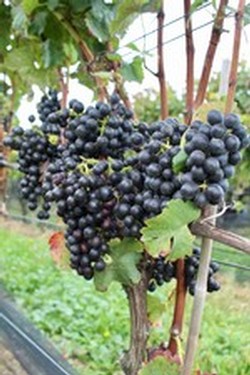 A Closer Look at Suhru Teroldego
A Closer Look at Suhru Teroldego
Grown in Southold, NY, Teroldego is known for being an early ripening (on the North Fork, Teroldego is usually picked around the second week of October, before Merlot) and early release wine. A light/medium bodied wine and a distant cousin if Syrah, Teroldego is designed to be enjoyed now and is not a wine that benefits from bottle aging.
After bring picked in early October, our Teroldego is fermented in open top tanks and then spends 9 months aging in French oak.
An extremely food-friendly wine, Teroldego pairs beautifully with a wide range of dishes including duck, swordfish, salmon, and gamey poultry. For more adventurous pairings try a bottle with teriyaki salmon, apple pie, walnut goat cheese pear salad, or brisket!
Harvest Update: September 2020
Harvest has started on the North Fork! While we are yet to begin harvesting our vineyards, a number of wineries across Long Island are busy bringing in fruit for their sparkling wines!
This is one of our favorite times of the year as this is when all the action happens at the winery! Over the next few months we will be keeping you up-to-date on the Blog and on our Instagram account on everything going on in the winery and the vineyard during the 2020 Harvest!
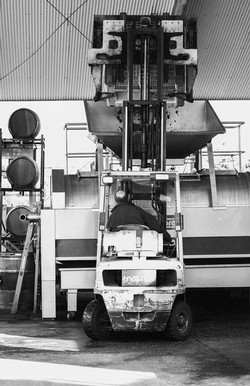 What's Happening in the Winery
What's Happening in the Winery
With the beginning of our harvest season quickly approaching, this week has been spent preparing for fruit receival and readying the winery for the first grapes to arrive (aka lots of cleaning!) As our winemaker Russell loves to say "Winemaking is 70% Sanitation, 20% Perspiration, 9% Inspiration, and 1% Degustation, but only at the end of the day!"
When grapes arrive at the winery their first stop in their journey into wine is the crush-pad which is where all the action happens. The crush-pad is home to the de-stemmer, presses, weight scale, and a number of other machines that ensure that the first stages of the grapes post-picking journey to become wine goes smoothly. We have been readying our crush-pad for the last few weeks and just had new membranes installed to ensure everything is ready to go for the 2020 harvest season! Over the next few days the winery crew will be busy cleaning and sanitizing all the harvest equipment: hoses, piping, hoppers, destemmer/crusher and the presses in preparation to receive fruit, which could potentially be coming as early as next week.
While all of this is going on outside on the crush-pad the cellar is being prepared for harvest as well, cleaning tanks, making sure everything is organized, and preparing several harvest devices such as the 'punch-down tool' for red wine fermentations 5-6 weeks away.
What's Happening in the Vineyard
In the vineyards, Russell is carefully watching the grapes and monitoring their sugar content (Brix) which is used to determine the grapes ripeness to determine when to pick our grapes. He is regularly walking the vineyards, inspecting the grapes, speaking to the vineyard managers, and testing the grapes. As we get closer to picking he will be carefully monitoring the weather. The goal is always to harvest grapes after several dry days. Whenever possible you want to avoid harvesting shortly after a rain as the grapes will be bloated with water they absorbed.
A Note from Winemaker Russell Hearn
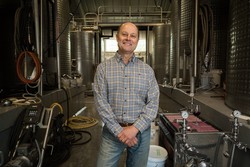 I never make predictions on the quality of the Harvest until 'all the fruit is in the building' however, 2020 is setting up very nicely and we are anticipating a good harvest. The growing season started very slowly this Spring with May and early June being much cooler and wetter than normal, which seems to be becoming the norm on the East End the last few years. Since then we have enjoyed a beautiful run of warm weather with very little rain (what we hope for in an ideal grape growing season). We are below normal in rainfall since June and have needed to drip irrigate several times during the last three months, which is always a good sign for quality. When the potato and sod farmers are grumbling about the dryness, the vineyard managers and winemakers are smiling! Grapes vines like a little stress during the growing season, with long dry summers and minimal rain being their ideal growing season. This harvest is shaping up to be very similar to 2019, so with some continued dry conditions I am very hopeful.
I never make predictions on the quality of the Harvest until 'all the fruit is in the building' however, 2020 is setting up very nicely and we are anticipating a good harvest. The growing season started very slowly this Spring with May and early June being much cooler and wetter than normal, which seems to be becoming the norm on the East End the last few years. Since then we have enjoyed a beautiful run of warm weather with very little rain (what we hope for in an ideal grape growing season). We are below normal in rainfall since June and have needed to drip irrigate several times during the last three months, which is always a good sign for quality. When the potato and sod farmers are grumbling about the dryness, the vineyard managers and winemakers are smiling! Grapes vines like a little stress during the growing season, with long dry summers and minimal rain being their ideal growing season. This harvest is shaping up to be very similar to 2019, so with some continued dry conditions I am very hopeful.
New September Releases
We have a number of exciting new Releases this September that we are excited to share with you including the 2019 vintage releases of our Pinot Grigio, Sauvignon Blanc and brand new, soon-to-be-released Teroldego!
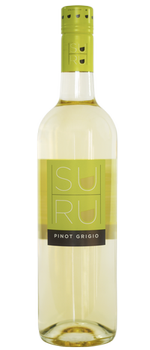 2019 Pinot Grigio
2019 Pinot Grigio
Our signature wine, we are very excited to release this new Pinot Grigio! In 2019 we saw a slow start to the growing season with a cold wet May but the summer months more than made up for it with a hot, dry summer and minimal rainfall which is exactly what we are looking for when it comes to grape growing!
With a strong growing season behind us Russell was able to do what he does best and showcase the bright, crisp, fruity flavors of the berries into the Suhru Pinot Grigio we all know and love. The stainless steel fermented white is 100% Pinot Grigio and recently received a 89pt score from Wine Advocate!
The 2019 vintage is bright and crisp, with nice lemon and lime zest notes jumping from the glass and a nice hint of granny smith apple and bosc pear on the palate. The crisp, bright flavors and refreshing acidity offers a diverse range of food compliments. Try a glass with lighter flavors such as fish, salads, chicken, cheese, or a meatier fish like swordfish. Happy sipping!
Want to learn more about our Pinot Grigio? Check out the Tasting Notes and our recent blog on the History of the Grape.
2019 Sauvignon Blanc
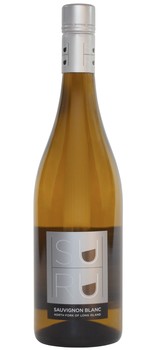 This may be our best Sauvignon Blanc yet! As I said above with the Pinot Grigio, 2019 was a great growing season for white wines and the Sauvignon Blanc fruit was no exception. Deliciously fruity, the 2019 Sauvignon Blanc has hints of gooseberry on the nose giving way to lush, rich flavors on the palate.
This may be our best Sauvignon Blanc yet! As I said above with the Pinot Grigio, 2019 was a great growing season for white wines and the Sauvignon Blanc fruit was no exception. Deliciously fruity, the 2019 Sauvignon Blanc has hints of gooseberry on the nose giving way to lush, rich flavors on the palate.
Past vintages of our Sauvignon Blanc have leaned into the tropical notes with passion fruit and pineapple being the distinctive characteristics. With the 2019 we are seeing more complexity, richness, and depth coming through while still maintaining those bright crisp flavors that we all love.
The 2019 Sauvignon Blanc has a bright acidity on the palate with notes of lime, a light grassiness and a subtle richness. Fuji pear notes and a round mouthfeel give way to a soft minerality and defined brightness on the finish, all showcasing the distinctive characteristics of the varietal which make it such a beautiful pairing with seafood and local produce.
We are also happy to announce that the 2019 Sauvignon Blanc received a 89pt score in the most recent publication of Wine Advocate!
Want to learn more about our Sauvignon Blanc? Check out the Tasting Notes!
 2019 Teroldego
2019 Teroldego
We are beyond excited to be announcing the upcoming release of the newest addition to the Suhru Wines portfolio, our brand new 2019 Teroldego!
Teroldego is a lesser known Northern Italian varietal (best known as the nephew of an old French variety that was the parent of Syrah) and is a rarity on the North Fork. To our knowledge there is only one vineyard on the East End with this grape variety planted and we are very excited to have gotten our hands on it!
This unique red wine is the perfect Fall release as it is rich with warm baking spices on the nose with hints of anise, cinnamon, and red currant. Dark red, almost black in color and completely opaque in the glass this medium-light bodied wine is deliciously fruity with red raspberry notes mingled with wild briar fruit.
An extremely food friendly wine, this Teroldego pairs nicely with fish, duck, swordfish, salmon, and gamey poultry. For more adventurous pairings try the bottle with teriyaki salmon, apple pie, walnut goat cheese pear salad, or brisket!
This wine will be released on our website on Tuesday, September 15th and in our Tasting House on Thursday, September 17th. Want to learn more about this exciting new red? Check out the Tasting Notes and keep an eye on our Blog for an in-depth History of the Grape!

